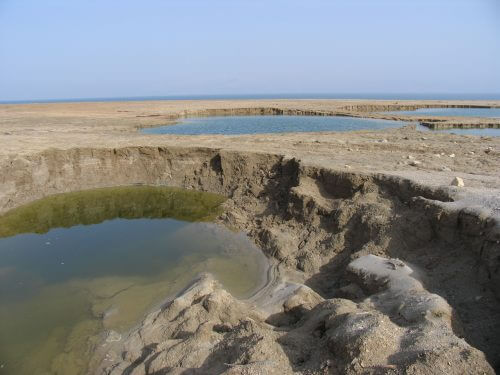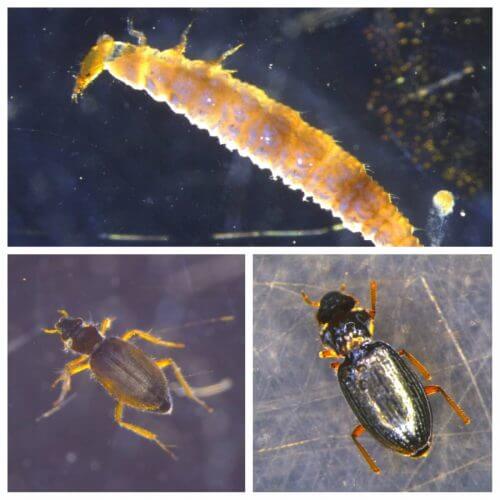The sinkholes in the Dead Sea are usually seen as a source of destruction and danger, but new research has found that they are also a habitat that supports the development of local animals

By Maya Falah, Angle, Science and Environment News Agency
How does an area that is a unique tourist site in the world turn from a flourishing and prosperous place into a desolate and barren place, in just a few decades? A paradise full of nature, date plantations and heritage sites, the Dead Sea has become an almost ghostly area - where plantation after plantation is closed due to the horror of the sinkholes, beaches are closed to bathers and even the roads are no longer safe.
All this started in the 60s of the last century, and since then the level of the Dead Sea has been falling at a rate of about a meter per year on average - an accelerated decline even in relation to the natural changes in sea level throughout history - this is due intense human activity, which manifests itself in the diversion of the water that originally flowed into the Dead Sea so that it would be used for irrigation and drinking, and in the pumping of water by the Dead Sea factories located in its south for the purpose of producing potassium.
Apart from the drop in the level, one of the dominant phenomena in the landscape of the Dead Sea today are the sinkholes - which this significant drop in the level caused in the last four decades to form. The rate of development of these pits increasing gradually, and even though the sinkholes began to form along the seashores already in the 80s, over 85 percent of the sinkholes were created after the year 2000, and today there are already יותר M-6,000 sinkholes along the west coast of the sea.
Now, to the side Extensive rehabilitation programs that strive to restore the area to its greatness as a leading tourist site, among other things while turning the sinkholes into a tourist attraction, a new study shows that the sinkholes may have another role in the restoration of the area: it turns out that the local animals have learned to use them to their advantage, and they use them as a place to live.
When a fly and a beetle meet in a sinkhole
Although they are an example of environmental damage that occurs as a result of human activity, the sinkholes are here to stay, and as such they have become integrated into the complex ecosystem of the Dead Sea region. At the bottom of the sinkholes, some of which have been in the area for many years, we sometimes hope for "fresh" water that consists of rainwater, groundwater and spring water. In some cases, the water becomes a habitat for various animals, mainly invertebrates, thus supporting the preservation of biodiversity in the area.
As part of his master's degree research, Ofir Hirschberg from the Department of Zoology at Tel Aviv University examined 94 of the sinkholes in the northern Dead Sea, to try and understand what is happening inside the water. The research, directed by Dr. Frida Ben-Ami, was funded by the Nature and Parks Authority and was carried out in collaboration with the Israel Geological Survey. The study was presented At the annual conference for science and the environment of the Israeli Society for Ecology and the Interdisciplinary Herzliya.

"In the winter of 2014-2015, we sampled the water in the sinkholes using a net designed to collect plankton," explains Hirschberg. "We preserved the samples we collected from the various sinkholes in ethanol and took them to the laboratory at Tel Aviv University, where we analyzed them one by one to understand the conditions that prevail in the water of that sinkhole, and which animals - if any - are found in them. In addition, each sinkhole was photographed and the quality of the water found in it was tested - the oxygen concentration, temperature, electrical conductivity and acidity.'
Indeed, in the water taken from the sinkholes, the researchers found many different animals. "We mainly found different types of insects," says Hirschberg, "including water beetles, mosquitoes and flies in different life stages, as well as clams and freshwater snails. Most of the animals we found are 'opportunistic' species, that is, those that know how to take advantage of the waterhole as soon as it fills up, and also know how to leave the sinkhole if and when it dries up." In an inspection conducted by Hirschberg in the summer later that year, he indeed discovered that during the summer many of the swamps dry up, and then these animals can no longer be found in them.
A finding that surprised the researchers was that even in sinkholes in which relatively difficult conditions prevailed - that is, high salinity and high acidity, two conditions that make it difficult for most species to develop life - animals were found that manage to utilize the water body. "These are animals that are known to be resistant to a relatively wide range of environmental conditions," says Hirschberg, "yet we were surprised to see that they manage to exist and reproduce even in the relatively extreme conditions we found. The water in the sinkholes is often of high salinity, saltier than the water of the Mediterranean Sea, for example.'
A new reality in the area
Indeed, it seems that the large number of sinkholes, as well as the varying conditions between sinkholes and between the sinkholes and their external environment, allow a diverse population of animals to develop and thrive in them. "The species we found in each sinkhole were affected by the acidity and salinity of its waters, which differed from one sinkhole to another. Not every species can survive in every environment; "There are species that showed a preference for high salinity, and vice versa," says Hirschberg. "By the way, in the sinkholes where the salinity was very high - at the same level as the Dead Sea itself - we found no life."
As in other cases in nature, it turns out that a disaster for certain species (in this case - man) is actually a blessing for other species. Following the change of conditions in the area by man, which caused the formation of the sinkholes, a new reality was created, which affects the entire ecosystem and the animals in it. Although, according to Hirschberg, most of the species found are species that already existed there before, the new habitat may affect the animal balance in the Dead Sea region. "The swamps are ecosystems in themselves, and they constitute a habitat of stagnant water - similar to winter puddles. Although even before these species could find a place to exist, now the formation of sinkholes greatly increases the amount of standing water habitats in the area and can allow them to expand their presence in the area. The sinkholes may, in fact, change the identity of common species in the region.'

2 תגובות
The beetles in the picture are from the beetle family, they don't live in water. If they were found using a plankton net, it means they fell into the sinkhole and drowned. It seemed to me that the evidence actually shows that the sinkhole is harming local life. Or maybe they brought wrong pictures?
Interesting but:
It turns out that all the species found in the sinkholes
They are those that live around the Dead Sea in different habitats such as,
Sweet springs, salty springs, seasonal puddles, etc.
so that there is no additional change or advantage in the "new habitat" created,
On the contrary, since the formation of sinkholes causes serious damage to existing habitats,
That's why the sentence: "Possibly the sinkholes have another role in the restoration of the area"
It is naive and at best wrong,
It is written: " ....high acidity .... " is that so ? no and no
Because the pH of sea water ranges from 7.4 to 8.3, hence the sea is somewhat alkaline.
It is appropriate that the writers and researchers return to the classroom
And remember the difference between acidity and alkalinity...
The title and opening paragraph are misleading at best...
For some reason, the lists in "Angle" are amateurish at best
And in the least flattering cases mistakes
And it's a shame that...